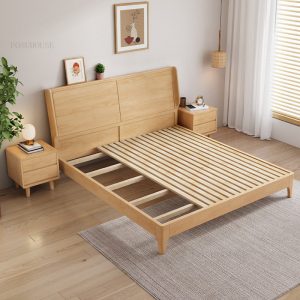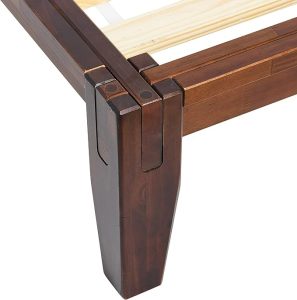Japanese Joinery Bed Frame: Unveiling the Art of Woodwork
Dive with me into the world of the Japanese Joinery Bed Frame – a symbol of ancient craftsmanship seamlessly merged with modern bedroom aesthetics. Every curve, every joint, speaks of a rich history that we’re about to unravel.
A Brief History of Japanese Joinery
The art of Japanese joinery, known as “tsugite”, traces its roots back several centuries. Originating from the Land of the Rising Sun, this exquisite woodworking craft transcended simple functionality. Rather than merely creating furniture, artisans sought to capture the essence and spirit of nature in their creations. As temples, shrines, and homes in ancient Japan were built using these intricate methods, the timeless aesthetics and durability of Japanese joinery quickly became symbols of tradition and artistry. Over time, while technologies advanced, the core principles and admiration for this craft remained steadfast, with modern artisans still upholding the techniques passed down through generations.
Distinctive Features of a Japanese Joinery Bed Frame
The Magic of No-Nail Construction
At first glance, the idea of constructing robust, long-lasting furniture without nails or screws seems fantastical. However, in the realm of Japanese joinery, it’s a celebrated reality. These joinery techniques focus on the intricate interlocking of wooden pieces, a method that requires immense precision and understanding of wood grain and its natural properties. The interlocked joints, when executed correctly, can bear loads and withstand stress, often outperforming their nailed counterparts. Not only does this no-nail approach amplify the aesthetic appeal, but it also adds to the furniture’s durability and strength. In essence, this magical method speaks to an ancient bond between human ingenuity and nature’s versatility.
Beauty in the Details
In the world of Japanese joinery, details are paramount. Each piece, no matter how minute, serves a purpose, both functionally and aesthetically. The interlocking patterns, which might appear as mere ornate designs to an untrained eye, are meticulously crafted, serving both form and function. The attention to detail reflects a deeper philosophy: a harmony between form and function, where neither overshadows the other. This harmonious blend results in furniture pieces that are not just tools of utility, but also standalone works of art. Every curve, every joint, and every grain tells a story, echoing the craftsman’s dedication and the wood’s journey from the forest to the workshop.

Benefits of Choosing Japanese Joinery for Bed Frames
Japanese joinery, a timeless woodworking technique, is not just about crafting furniture; it’s about creating lasting art. Opting for a bed frame that employs these methods means integrating centuries of tradition and craftsmanship into one’s bedroom. It’s a testament to appreciating the fine balance between functionality and art, where every joint has a purpose and tells a story.
Durability and Strength: The Japanese joinery technique is renowned for its remarkable durability. Unlike conventional frames that might rely heavily on nails or screws, these designs are held together by precision-cut joints. This ensures that the bed frame can bear substantial weight and resist wear and tear over years, even decades. In essence, choosing a bed frame built with Japanese joinery is an investment in longevity, making it an eco-friendly choice by reducing the need for frequent replacements.
Aesthetics and Minimalism: In the world of design, Japanese aesthetics are often associated with minimalism and simplicity. Japanese joinery bed frames exude an understated beauty, where the emphasis is placed on the wood’s natural grain and the intricacy of the joints. This minimalist approach not only makes the frame a versatile piece that can fit into various interior design themes but also turns the bed into a serene focal point in the bedroom. It’s an embodiment of the principle that true beauty lies in details and simplicity.

Constructing Your Japanese Joinery Bed Frame
Preparing the Materials
Before embarking on the journey of crafting a Japanese joinery bed frame, it’s essential to prepare the right materials. Quality is paramount; hence, it’s advised to select premium hardwoods like oak, cedar, or maple that promise durability and a beautiful finish. Once you’ve sourced the right wood, it must be cut to precise measurements. Attention to detail during this phase is crucial, as even a minor discrepancy can affect the final assembly. Additionally, ensure the wood is properly seasoned to prevent future warping or shrinkage, which could compromise the integrity of the joinery connections.
Joinery Techniques to Master
Japanese joinery is an intricate art, boasting various techniques perfected over centuries. Some of the fundamental techniques that one should aim to master for bed frames include the ‘Dovetail’ joint, known for its resistance to being pulled apart, and the ‘Mortise and Tenon,’ revered for its strength and functionality. Another essential technique is the ‘Finger’ or ‘Box’ joint, which is particularly useful for corners and provides an excellent visual appeal. It’s worth noting that mastering these techniques demands patience and practice, but the end result—a bed frame of unparalleled strength and beauty—makes the effort entirely worthwhile.

Care and Maintenance Tips
Even though Japanese joinery bed frames boast durability, they still require consistent care to preserve their beauty and function. To begin with, it’s vital to avoid placing them in direct sunlight, as prolonged exposure can lead to wood fading or warping. Regular dusting with a soft cloth will keep the wood’s surface pristine, and occasional polishing with a wood-specific product can enhance its shine. It’s also beneficial to inspect the joints periodically to ensure they remain tight and secure. In the case of any creaks or movement, consider consulting a woodworking expert to address the issue before it exacerbates.
Why They’re Worth the Investment
Investing in a Japanese joinery bed frame is not merely purchasing a piece of furniture; it’s acquiring a piece of art steeped in history and craftsmanship. These bed frames offer unmatched durability, often outlasting conventional counterparts by decades. Their no-nail construction ensures fewer weak points, leading to increased longevity. Furthermore, their unique aesthetic, characterized by clean lines and intricate joinery details, adds a touch of elegance and sophistication to any bedroom. Over time, this combination of form and function results in significant savings, both financially and environmentally, making them an investment worth every penny.
The absence of nails doesn’t mean a lack of strength. These bed frames are a testament to how nature, when respected and understood, provides us with everything we need. Their durability and stability often surprise those new to Japanese joinery.




